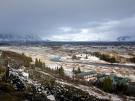Geysir is one of the main attractions on Iceland´s most popular
sightseeing tour; the Golden Circle. All of the world's spouting hot springs are named after the Geysir in Iceland –
so in all languages other than Icelandic, the word “geysir” or “geyser” is the name of the phenomenon
while in Icelandic it´s just the name of that single geyser. Even though the word refers to all geysers in general, there
is only one real Geysir and thats the one in south west Iceland.
The first tales of the Great Geysir are from the year 1294 when
a powerful earthquake shook the southern lowlands of Iceland and changed the geothermal area in Haukadalur valley. In written
annals tales report that "large hot springs" were formed, now thought to indicate that the hot springs started to spout. The
fame of the area increased in the following centuries, and especially that of the Geysir itself. This was not surprising as
erupting geysers were at the time not known in Europe outside Iceland. The geysers in Yellowstone and New Zealand obviously
were not discovered at that time.
During the centuries after 1294 the intensity of the thermal
ares apparently increased after large earthquakes, striking on average every 100 years.
Sadly the once great Geysir has
somewhat faded out and been "shy" for a couple of decades. However, another geyser – Strokkur – which is less
than 50m from Geysir erupts every 10 minutes or so. So you will see a geyser erupt or spout if and when you visit. Geysir
almost woke up after a 6,5 Richer scale earthquake on June 17 2000 - which accidentally is Iceland´s national holiday. When
Geysir performs it sure lives up to its name, as "The Geysir", extruding a jet of steaming water, often more than 60 to 80
meters high.
Geysir alternate and neighbor, though far less majestic, is Strokkur. Strokkur squirts it's steaming water
up 25 to 30 meters about once every ten minutes.
The Geyser area in south west Iceland is also great to
walk, there are many marked walking paths that that lead past steaming vents and colorful, mineral-rich mud formations and
hot springs that are just as beautiful.
Why
does a geyser erupt?
The geothermal area which is named after the famous Great Geysir
is a high temperature geothermal area. This term is used over geothermal systems that are within the zone of active rifting
and volcanism, and the temperature in the subsurface system is higher than 200°C at less than 1 km depth. The temperature
of the hot springs is up to 100°C and some are constantly boiling - if the temperature at depth rises above boiling the hot
springs erupt which means that they are geysers. Geysir’s eruption occurs when boiling water within the geyser, trapped
by cooler water above it, explodes, forcing its way to the surface. In more detail, geysers erupt because the thermal water
ascending throuh their channels boils at some depth below the surface.
As the water boils it converts into steam, and
as the steam occupies far greater volume than water the water above in the channel is thrown high up into the air. At about
23 m depth in the Geysir pipe the water is at 120°C temperature. It is in equilibrium with the pressuere of the water above
in the pipe, i.e. the weight of the water above keeps the boiling down.
At a depth of around 16 m, the temperature of
the water sometimes rises above boiling, seen as increased turbulence at the surface.
This turbulence (boiling) can increase
to the point where the water above in the pipe is lifted slightly, and a chain reaction starts - the pressure decreases making
further boiling possible and the water flashes into steam, resulting in an eruption in Geysir. The boiling now extends down
into the pipe, throwing more water into the air. When all the water in the pipe has been thrown away the water coming from
depth changes immediately into steam and a steam eruption follows the water eruption, whith accompanying noise. The water-phase
lasts for few minutes and the steam-phase considerably longer, graduately dying out and the cycle starts again.
For
centuries the eruptions in Geysir were considered supernatural and many teories were built to explain these wonders. Don´t
let the scientific explanations spoil your sense of wonder and magic. One final comment or request - The silica sinter is
delicate and althoug constantly being formed it takes years - reminding us to respect the beauty of this unique area and leave
the nature to evolve on its own. A good photograph is a much better souvenir than a piece of sinter.
Until 1894 the Geysir
area was owned by a local farmer. In that year the area was sold to James Craig (later Lord Craigavon), a whisky distiller and future Prime Minister of Northern Ireland. Initially he erected large fences around the site
and an entrance fee was charged for visitors wishing to view the geysers. The following year however Craig appeared to tire
of his project and gave the area as a present to a friend, E. Craig, who dropped the entrance fees. Later Craig's nephew Hugh
Rogers inherited the site. In 1935 he sold the site to film director Sigurđur Jónasson who subsequently donated it to the Icelandic people
in perpetuity.

